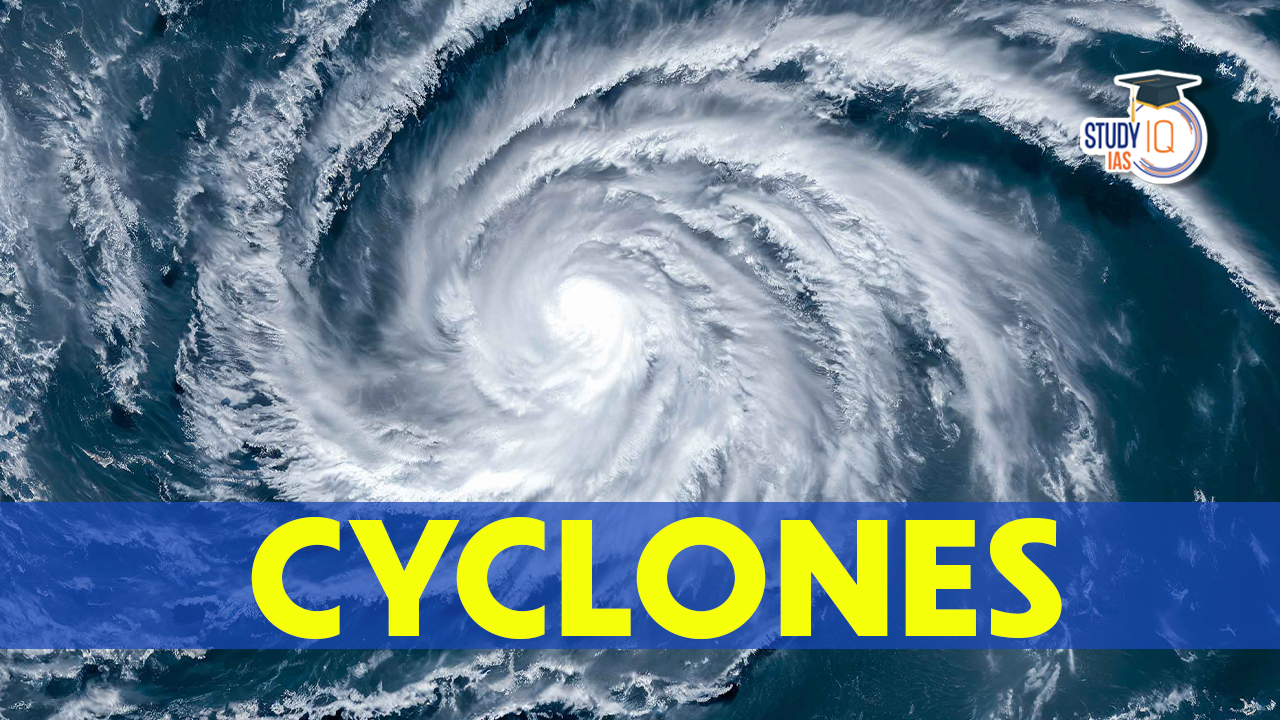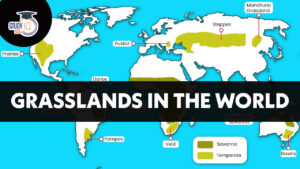Table of Contents
Context:
- The India Meteorological Department (IMD) reported that a cyclone is likely to develop in the Bay of Bengal, moving towards West Bengal and Bangladesh.
- This will be the first cyclone in 2024 in the North Indian Ocean basin, to be named Cyclone Remal, proposed by Oman.
What are Cyclones?
A Cyclone is a rapid inward air circulation around a low-pressure area. In other words, it is a low-pressure system that forms over warm waters. Cyclones can form over warm water in tropical and subtropical regions, and they are known for their destructive potential.
How are Cyclones Formed?
- As air gets warm over hotter regions it ascends, leading to low pressure at the surface it is covering.
- When air cools in colder areas it descends, leading to high pressure at the surface.
- In a depression or low-pressure situation, the air rises and blows in a specific direction around the low-pressure centre.
- This direction is due to the Coriolis effect, which is the result of the Earth’s rotation on its axis.
- The Coriolis effect causes the air to deflect to the right in the Northern Hemisphere and to the left in the Southern Hemisphere, leading to the anticlockwise and clockwise circulation around the low-pressure centre, respectively.
- This process is crucial in the formation and intensification of a cyclone, and it can lead to severe weather events such as heavy rainfall, strong winds, and storm surges.
| Pressure system | Pressure condition at the centre | Pattern of wind direction | |
| Northern Hemisphere | Southern Hemisphere | ||
| Cyclone | Low | Anticlockwise | Clockwise |
| Anti-cyclone | High | Clockwise | Anticlockwise |
Types of Cyclones
The article also mentions that cyclones are broadly categorized into two types: extratropical cyclones and tropical cyclones, as classified by the National Disaster Management Authority.
Tropical Cyclones
- These are intense circular storms that originate over warm tropical oceans in tropical areas and move over to the coastal areas bringing about large-scale destruction caused by violent winds, very heavy rainfall and storm surges.
- They are characterized by low atmospheric pressure.
- The conditions favourable for the formation and intensification of tropical storms are:
- Large sea surface with a temperature higher than 27° C.
- Presence of the Coriolis force.
- Small variations in the vertical wind speed.
- A pre-existing weak low-pressure area or low-level-cyclonic circulation.
- Upper divergence above the sea level system.
Stages of Formation of Tropical Cyclones
The development cycle of tropical cyclones may be divided into three stages:
- Formation and Initial Development Stage:
- The formation and initial development of a cyclonic storm depends upon the transfer of water vapour and heat from the warm ocean to the overlying air, primarily by evaporation from the sea surface.
- It encourages formation of massive vertical cumulus clouds due to convection with condensation of rising air above the ocean surface.
- Mature Stage
- When a tropical storm intensifies, the air rises in vigorous thunderstorms and tends to spread out horizontally at the tropopause level.
- Once air spreads out, a high pressure at high levels is produced, which accelerates the downward motion of air due to convection.
- With the inducement of subsidence, air warms up by compression and a warm ‘Eye’ (Low pressure centre) is generated.
- The main physical feature of a mature tropical cyclone in the Indian Ocean is a concentric pattern of highly turbulent giant cumulus thundercloud bands.
- Modification and Decay
- A tropical cyclone begins to weaken in terms of its central low pressure, internal warmth and extremely high speeds, as soon as its source of warm moist air begins to ebb or is abruptly cut off.
- This happens after its landfall or when it passes over cold waters.
Terminology for Tropical Cyclones
- These storms are also known as typhoons or hurricanes, depending on the region they occur in.
- They are called Typhoons in the China Sea and Pacific Ocean; Hurricanes in the West Indian islands in the Caribbean Sea and Atlantic Ocean; and Tornados in the Guinea lands of West Africa and southern USA.; Willy-willies in north-western Australia and Tropical Cyclones in the Indian Ocean.
Extra-Tropical Cyclones
- Also Known As:
- Temperate cyclones
- Middle-latitude cyclones
- Frontal cyclones
- Wave cyclones
- These are also known as temperate cyclones, middle-latitude cyclones, frontal cyclones, or wave cyclones.
- These are active above the mid-latitudinal region between 35° and 65° latitude in both hemispheres.
- Unlike tropical cyclones, which derive their energy from warm ocean waters, extra-tropical cyclones are fuelled by the temperature contrast between warm and cold air masses in the atmosphere.
- The direction of movement is from west to east and is more pronounced in the winter seasons.
- These storms typically occur in the middle latitudes, outside the tropics, and are associated with fronts (boundaries between air masses of different temperatures) and other weather systems.
- Extra-tropical cyclones can also bring strong winds, heavy rain, and other hazards.
Formation of Extra-tropical Cyclones
- The origin and development of temperate cyclones can be explained by the Polar Front theory.
- According to this theory, the warm-humid air masses from the tropics meet the dry-cold air masses from the poles and thus a polar front is formed.
- The cold air mass is denser and heavier and due to this reason, warm air mass is pushed up.
- This interaction of cold and warm air masses creates instability and a low pressure is created at the junction, particularly in the center of interactions.
- Thus, a void is created because of the lessening of pressure. The surrounding air rushed in to occupy this void and coupled with the earth’s rotation a cyclone is formed.
- Extra-tropical cyclones present a contrast to the more violent cyclones or hurricanes of the tropics, which form in regions of relatively uniform temperatures.
Air Mass
- Air Mass is an extremely large body of air whose properties of temperature and moisture content (humidity), at any given altitude, are similar.
- It can cover hundreds of thousands of square miles of area.
- It may have only a little horizontal variation in temperature and moisture throughout the air mass.
- When an air mass remains over a homogenous area for a sufficiently longer time, it acquires the characteristics of the area. The homogenous regions can be the vast ocean surface or vast plains.
Fronts
When two different air masses (having distinctly different properties) meet, the boundary zone between them is called a front. There are four types of fronts:
- Stationary front: When the front remains stationary, it is called a stationary front.
- Cold front: When the cold air moves towards the warm air mass, its contact zone is called the cold front.
- Warm front: If the warm air mass moves towards the cold air mass, the contact zone is a warm front.
- Occluded front: If an air mass is fully lifted above the land surface, it is called the occluded front.
- The fronts occur in middle latitudes and are characterized by steep gradients in temperature and pressure. They bring abrupt changes in temperature and cause the air to rise to form clouds and cause precipitation.
Cyclone Season in India
Typically, tropical cyclones in the North Indian Ocean region (Bay of Bengal and Arabian Sea) develop during the pre-monsoon (April to June) and post monsoon (October to December) periods.
Why generally cyclones do not form during active monsoon season?
- Vertical wind shear: During the monsoon season, there exists very high vertical wind shear due to strong monsoon currents. This dampens the intensification in strength and wind speeds of cyclones. As a result, clouds do not grow vertically and monsoon depressions often fail to intensify into cyclones.
- Strong opposing winds: Generally, the monsoon conditions are not favourable for cyclones to develop in the North Indian Ocean due to the presence of strong opposing winds i.e. “the lower atmospheric winds are in one direction (southwesterly) and the upper atmospheric winds are in the other direction (northeasterly). This prevents a cyclone from developing vertically.”
Climate Change and Cyclones
- Climate change is expected to affect the frequency, intensity, and patterns of tropical cyclones.
- Warmer ocean temperatures, rising sea levels, and changes in atmospheric circulation patterns are all factors that contribute to the changing nature of tropical cyclones.
- Increase in Intensity: One of the most significant impacts of climate change on tropical cyclones is the potential increase in their intensity.
- Warmer ocean temperatures provide more energy for tropical cyclones to form and strengthen, leading to more frequent and more severe storms.
- Studies have shown that the proportion of tropical cyclones that reach category 4 or 5 intensity has increased in recent decades, and this trend is expected to continue in the future.
- Changing Pattern: Another impact of climate change on tropical cyclones is their changing patterns.
- In some regions, the frequency of tropical cyclones may decrease, while in others, it may increase.
- For example, some studies have suggested that the number of Atlantic hurricanes may decrease in the future, while the number of storms in the Pacific may increase.
- Additionally, the timing of tropical cyclone seasons may shift, with some regions experiencing storms earlier or later than in the past.
- Rising sea levels also contribute to the changing nature of tropical cyclones.
- Higher sea levels mean that storm surges caused by tropical cyclones can penetrate further inland, causing more extensive damage and posing a greater risk to coastal communities.
- Increased Cyclonic Activity in the Arabian Sea: Recent research suggests that there has been an increase in the number of tropical cyclones forming in the Arabian Sea in recent decades, and this trend is expected to continue in the future due to the effects of climate change.
- The Arabian Sea is a region of the northern Indian Ocean that is bounded by the Indian subcontinent to the east, the Arabian Peninsula to the west, and the Somali Peninsula to the south.
- Historically, this region has seen relatively few tropical cyclones compared to other parts of the world, such as the Western Pacific and the Atlantic.
- However, in recent years, there has been an increase in the number of cyclones forming in the Arabian Sea.
- According to studies, the number of cyclones forming in the Arabian Sea has increased by about 50% over the past four decades, and the trend is expected to continue in the future.
- This increase in cyclone activity is linked to rising sea surface temperatures in the region, which are a result of global warming and climate change.
- The impact of this increase in cyclone activity could be significant for the coastal communities in the region, which are vulnerable to the effects of tropical cyclones, such as storm surges, heavy rainfall, and strong winds.
Naming of Cyclones
- Cyclones are named by the regional specialized meteorological centres (RSMCs) and Tropical Cyclone Warning Centers (TCWCs) across the world.
- The India Meteorological Department (IMD) is one of the RSMCs and is responsible for naming cyclones that develop over the north Indian Ocean, including the Bay of Bengal and the Arabian Sea, by following a standard procedure.
- In 2000, a group of nations comprising Bangladesh, India, the Maldives, Myanmar, Oman, Pakistan, Sri Lanka, and Thailand decided to start naming cyclones in the region.
- After each country sent in suggestions, the WMO/ESCAP Panel on Tropical Cyclones (PTC) finalized the list.
- The list of 169 cyclone names released by the IMD in 2020 was provided by these countries, with 13 suggestions from each of the 13 countries.
- In 2018, the WMO/ESCAP expanded to include five more countries: Iran, Qatar, Saudi Arabia, the United Arab Emirates, and Yemen.
- The cyclone names are assigned in a sequential manner, with names starting from A to Z, excluding Q, U, X, Y, and Z.
Significance of Naming of Cyclones
It is important to name cyclones because:
- Adopting names for cyclones makes it easier for people to remember.
- With a name, it is also easy to identify individual cyclones, create awareness of its development, rapidly disseminate warnings to increase community preparedness and remove confusion where there are multiple cyclonic systems over a region.
Cyclone Management
The necessary steps for effective management of cyclones in India include:
- According to the Global Climate Risk Index Report 2021: India ranked the 7th worst-hit country globally in 2019 due to the frequent extreme weather-related events & ranks 1st in human deaths and economic losses due to extreme weather-related events.
- As per the Asian Development Bank’s report: India would suffer a loss of around 1.8% of GDP annually by 2050 from climate-related events.
- Cyclones between 1999 and 2020 inflicted substantial damage to public and private properties and have led to an increase in the fiscal burden of governments.
- Long-term mitigation measures: It is essential to adopt cost-effective, long-term mitigation measures such as building cyclone-resilient infrastructure, improving river connectivity to prevent waterlogging, installing disaster-resilient power infrastructure, and creating awareness campaigns.
- Improvement in early warning systems: This is critical to giving people enough time to prepare and evacuate before a cyclone hits. The early warning system needs to be efficient and widespread so that everyone in the affected areas is informed.
- Construction of evacuation shelters: Safe and secure evacuation shelters should be constructed in cyclone-prone districts so that people can take refuge during a cyclone.
- Revamp disaster preparedness measures: Disaster management activities need to be improved to ensure that relief reaches people in need on time.
- Regeneration of mangroves: Mangroves help to minimize the impact of cyclones by acting as a natural barrier against storm surges. Therefore, there should be an emphasis on regenerating mangroves in coastal regions.
- Coordination between the Centre and the States: Healthy coordination between the Centre and the States is crucial to designing and implementing effective disaster mitigation measures.
- Capacity building of all stakeholders involved: Training and capacity building of all stakeholders involved in disaster management activities, including government officials, first responders, and the public, is essential to ensure effective and coordinated responses to cyclones.
| Other Important Articles | |
| Cyclone Michaung | Formation of Cyclones |
| Cyclone Biparjoy |
How Cyclones Affect Monsoon Onset |


 Critical Minerals, Key Issues, Importanc...
Critical Minerals, Key Issues, Importanc...
 Grasslands in the World, Map, Types and ...
Grasslands in the World, Map, Types and ...
 Places in News for UPSC 2025 for Prelims...
Places in News for UPSC 2025 for Prelims...





















